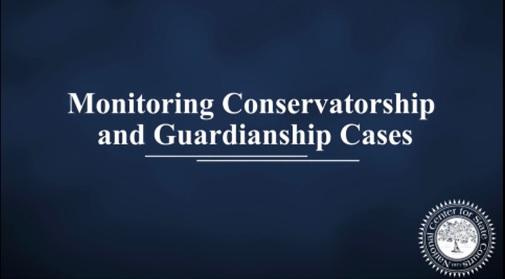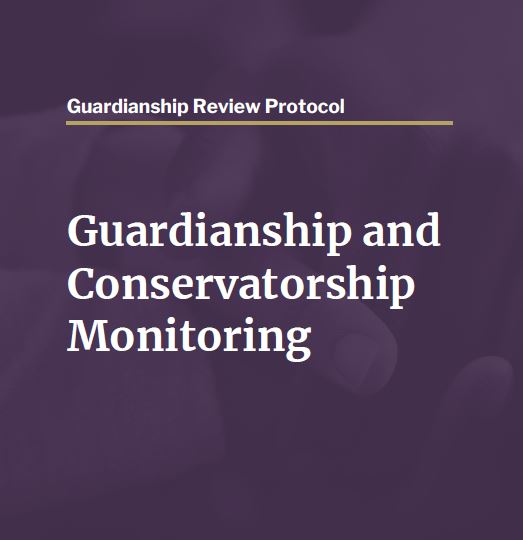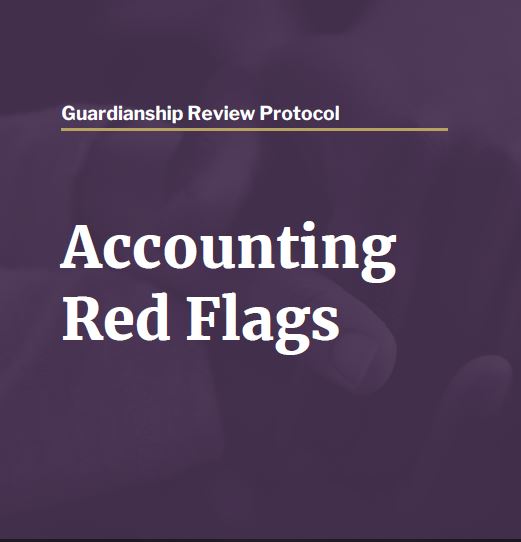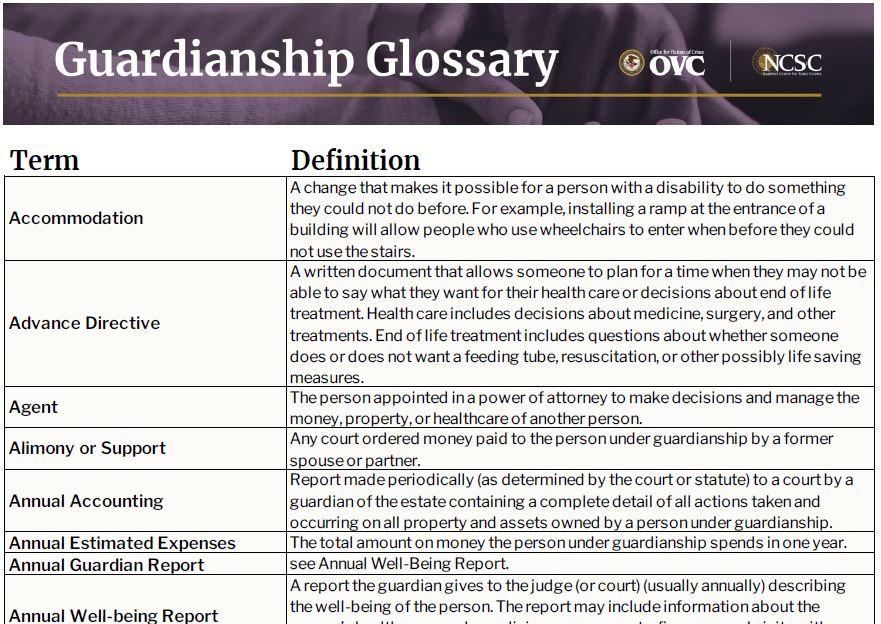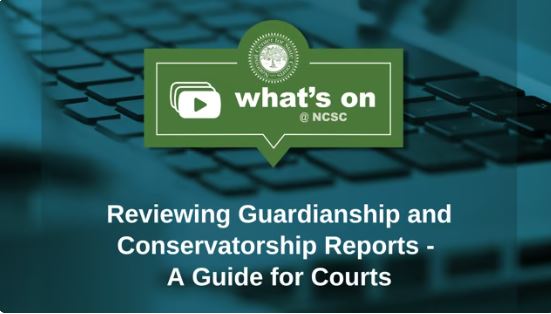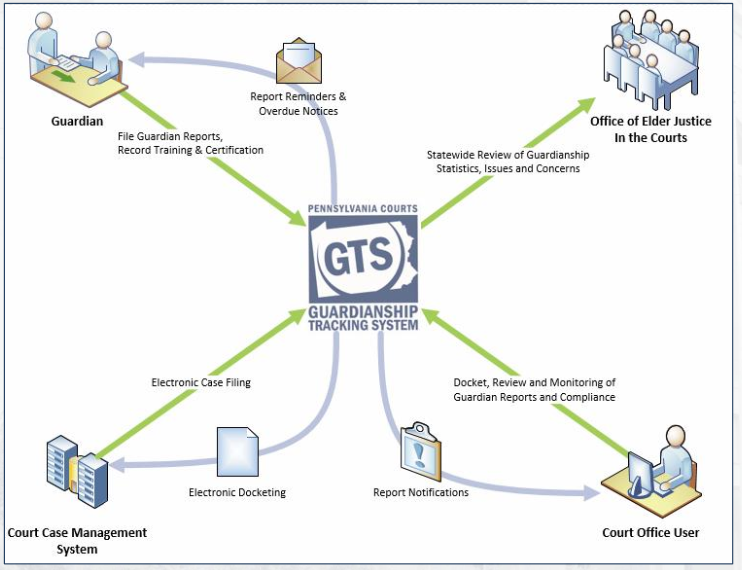Monitoring Conservatorships
The court’s duty to protect the well-being of an individual does not end when it appoints a conservator. Courts have an ethical, moral and legal duty to monitor conservatorship cases given that establishing a conservatorship is a significant curtailment of civil rights. The National College of Probate Judges Court Standards on monitoring state, “The safety and well-being of the respondent and the respondent’s estate remain the responsibility of the court following appointment.” One judge observed, “In reality, the court is the guardian; an individual who is given that title is merely an agent or arm of that tribunal in carrying out its sacred responsibility.”
The National Probate Court Standards (Standard 3.3.17) and Recommendations adopted at the Third National Summit on Guardianship (Recommendation #2.3) are consistent in what constitutes basic monitoring practices:
Probate court should monitor the well-being of the respondent and the status of the estate on an on-going basis, including, but not limited to:
- Determining whether a less restrictive alternative may suffice;
- Ensuring the plans, reports, inventories and accountings are filed on time;
- Reviewing promptly the contents of all plans, reports, inventories and accountings;
- Independently investigating the well-being of the respondent and the status of the estate, as needed; and
- Assuring the well-being of the respondent and the proper management of the estate, improving the performance of the guardian/conservator and enforcing the terms of the guardianship/conservatorship order.
Resources:
Judicial actions & monitoring strategies
This video offers an overview of monitoring strategies and best practices. It is part of NCSC's Probate Court Staff Video Series, which emphasizes important aspects of case management, report tracking, responses to potential fraud and abuse, and financial monitoring, including comparing assets, expenses and budgets over time and highlighting common problem areas to look out for.
Judicial officers and the court should consider the following strategies after appointing a new conservator. These actions take place initially after appointment or throughout the life of a conservatorship case. There may be overlap in the time period in which some of these responses are implemented and some may not be applicable at all.
Also read NCSC Background Brief No. 3: Detecting Exploitation by Conservators - Court Monitoring.
The monitoring process begins with the establishment of a conservatorship and the submission of initial reports. Increasingly, there are greater demands that guardians and conservators submit prospective care plans and estate management plans as well.
The National Probate Court Standards identifies some basic timeframes and expectations for the submission of reports (Standard 3.3.16), which are summarized below.
Conservatorship filings
Required at the hearing or within 60 dates:
- Inventory of the respondent's assets
- Plan on how resources will be allocated to meet respondent's needs
Notices required by the court:
- Submit for court approval amended plans if there are any anticipated or real deviations from the approved plan.
Follow-up reports:
- Annual accountings or updates
The conservator report should include:
- Statement of all available assets
- Anticipated financial needs and expenses of the respondent
- Investment strategy and asset allocation to be pursued, if applicable, considering the purposes for which funds are to be managed
- Services and care provided to the respondent and their costs
- Significant actions taken
- Expenses to date
While annual updates are required by statute in nearly all states, courts have flexibility in terms of requiring more frequent updates and additional information in cases that may benefit from an increase in oversight.
Courts should have standardized forms that are readily available online. Ideally, forms should be available at the state level and be easily downloadable and fillable, such as New Mexico's form for the conservator's report, or those provided by the California Judicial Council (see probate forms). The Minnesota Judicial Branch has online portals for guardianship and conservatorship reporting. In addition to standard forms, courts should consider requiring emergency plans and prospective care plans. Sample forms also can be found in the appendix of Guarding the Guardians: Promising Practices for Court Monitoring.
Resources
Review each Conservatorship based on circumstances.
DCM is a technique that allows courts to tailor the case management process to the requirements of individual cases. Rather than using a first-in, first-out basis that treats all cases identically, DCM uses a triage approach to assign cases into different categories, and hence, case management tracks to address abuse, neglect and exploitation. There are two common types: case-based and systemic review.
Examples:
Arizona: Improving Protective Probate Processes for Probate Case in Maricopa County Superior Court in Arizona (Also see below)
Idaho: Idaho courts utilize a Differentiated Case Management tool that triages Guardianship cases into three monitoring tracks: low, medium, high. It is a questionnaire (download here) that is to be completed on each guardianship case to assist in assigning monitoring efforts to the highest risk cases. Instructions can be found here.
Differentiated case management (DCM) in probate cases may be the wave of the future. Probate DCM to Protect Vulnerable Adults demonstrates how DCM can be used both before and after appointments of guardianships/conservatorships. The article is based on an assessment of the Probate and Mental Health Department of the Maricopa County Superior Court in Arizona.
The following table summarizes features of DCM noted in the article and Maricopa County assessment.
Phase DCM & actions
Pre-Appointment
Uncontested Petitions:
- Appointment of Fiduciary
Contested Petitions:
- Hearing on a Contested Petition
- Alternative Dispute Resolution
- Settlement Conference
- Trial on Contested Petition
- Appointment on Fiduciary
Post-Appointment
Minimum Risk:
Biennial telephone interview with respondent
Moderate Risk:
- Annual in-person visit with respondent
Maximum Risk:
- Combination of actions, including case compliance audit or forensic investigation
DCM can be readily applied at the pre-appointment stage as contested petitions can be readily identified by the court. However, the practice of separating guardians and conservators into appropriate risk levels after the appointment is challenging (see "Red Flags"). Included in the Arizona Supreme Court's Committee on Improving Judicial Oversight and Processing of Probate Court Matters Final Report is a risk assessment form (Appendix D) that provides a guide for placement of guardians/conservators into Triage Model "A" or Triage Model "B." Triage Model "A" calls for mandatory post-appointment monitoring and a visit from a volunteer guardian monitor within two years of the initial appointment. Triage Model "B" provides full judicial discretion in post-appointment monitoring activities.
The use of DCM in probate cases holds great promise. Unfortunately, a true risk assessment tool based on an empirical study identifying statistically validated factors does not exist. Rather, "red flags" that form the basis of assessment tools derive from anecdotal experiences. Thus, some caution must be used to determine the category of risk most appropriate to each case.
Resources
- NCSC's Caseflow Management Resource Guide
- This report summarizes NCSC’s evaluation of the Maricopa County Superior Court’s Probate Department, including their use of differentiated case management (DCM) and a Probate Evaluation Tool (PET) that is used to assign guardianships into low, medium and high monitoring levels.
- Examples of collaboration models are described in this Court Guide to Effective Collaboration on Elder Abuse.
- NCSC Background Brief No.4: Detecting Exploitation by Conservators - Systematic Approach
Actively monitor cases
Track cases and ensure reporting compliance
Ensure that plans, reports, inventories and accountings are filed on time by using checklists and tracking tools.
- Example: MyMNConservator (MMC)
If reports are not filed on time, take action: Court orders - Hearings - Sanctions
Use a review protocol and auditing and reporting checklists
Review promptly the contents of all plans, reports, inventories, and accountings.
With a monitoring protocol, the court can identify conservators who are struggling, guide a conservator who needs assistance in fulfilling their duties, and the court can stop a conservator from using their court appointed authority to abuse, neglect, or exploit an individual.
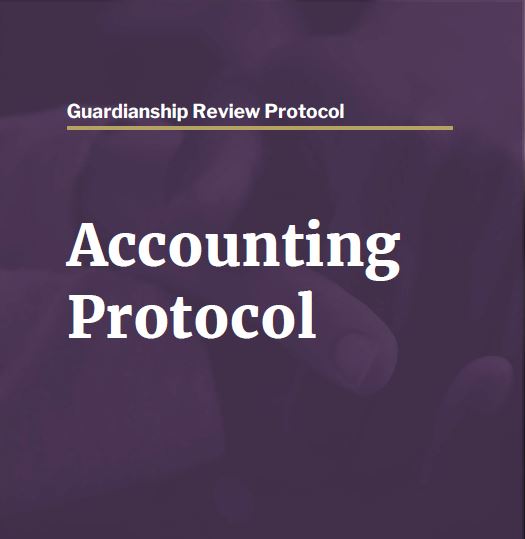
- Are listed assets and total asset values consistent with the application or petition?
- Do the obligations & expenses match the person’s physical and living conditions, including medical and residential arrangements?
- Compare current expenses to past year(s), any unusual, unexpected, or missing expenses that are unexplained?
- Is this conservatorship still appropriate?
| If an examination of the report show discrepancies, lack of documentation, or suspicious activity, consider: |
|---|
|
NCSC Protocol Supplemental Resources:
Further Examples:
- Minnesota: MyMNConservator (MMC)
- Pennsylvania: Pennsylvania Guardianship Tracking System (GTS)
- Travis County, TX: Guardianship Annual Accounting Checklist
- National Guardianship Association: Standards of Practice Checklist
- Charleston, SC: Annual Accounting Audit Sheet
- San Mateo, CA: Accounting Checklist in Conservatorship of the Estate Materials, p. 21
Forms and Checklist Examples:
- Travis County, TX: Guardianship Annual Accounting Checklist
- National Guardianship Association: NGA'S Standards of Practice Checklist
- Charleston, SC: Annual Accounting Audit Sheet
- San Mateo, CA: Accounting Checklist in Conservatorship of the Estate Materials, p. 21
Well-being checks
Examples: Florida Court Monitors, ABA Court Volunteer Guardianship Monitoring Handbooks
Needs assessment
Tool: Capacity assessment instruments
Court Visitor/Investigator
Require conservators to file a bank acknowledgment of any court-imposed restrictions.
Example: Utah Restricted Accounts
Require conservators to file an inventory and appraisal of the respondent’s assets and an asset management plan to meet the respondent’s needs and allocate resources for those needs, with annual accountings and updates thereafter.
Require conservators to provide copies of reports and accountings to family members and other interested parties. This keeps family members informed and allows family members to raise concerns with the court.
Results from a survey of judges and court managers on guardianship issues (Adult Guardianship Court Data and Issues) demonstrated the inability of many courts to provide basic data on guardianships and conservatorships and was the basis for the following recommendation:
Courts should explore ways in which technology can assist them in documenting, tracking and monitoring guardianships and conservatorships.
Recommendations from the Third National Guardianship Summit (Recommendation #2.5) encourage courts to use available technology to:
- Assist in monitoring conservatorships
- Develop a database of conservatorship elements, including indicators of potential problems
- Schedule required reports
- Produce minutes from court hearings
- Generate statistical reports
- Develop online forms and/or e-filing
- Provide public access to identified non-confidential, filed documents.
The Fourth National Guardianship Summit (2021) reiterated the need (in Recommendation 4.1):
Develop and implement technology that includes mechanisms to validate reports, flag potential problems, and track monitoring.
While many state courts are unable to properly monitor and document conservatorships, a number of courts are advancing the field by applying technology to these case types.
Generally, software applications can be used to enhance the court's responsibilities in overseeing the conservatorship process and to identify conservator activities that appear to be out of the norm. At its basic level, software can be used to create a "tickler" system that primarily reminds the court and notifies guardians of due dates of particular reports, such as annual accountings. At a higher level, financial-based software can be used to detect anomalies in conservatorships.
Online accounting software
The Minnesota Judicial Branch implemented a mandatory statewide web-based program for conservators to enter their account information online to the courts —— MyMnConservator (MMC). Conservators are required to submit an inventory to establish the assets and estate of the protected person, as well as annual accountings reporting each transaction, online. There are features in MMC that help balance accounts with bank statements and track categories of spending.
The court sites the following benefits:
- The software is able to produce comparative reports on demand.
- Analysis across all or a selected group of conservators/conservatorships can be completed quickly.
- Additional supplemental information is handled electronically.
- Audit abilities are greatly enhanced.
- The increased capabilities, documentation and accountability have a deterrent effect.
- Less staff time is required for reviewing and filing reports and associated activities.
- The system reduces paper and paperwork.
- MMC helps balance accounts with bank statements and track categories of spending.
A centralized, statewide Conservator Account Auditing Program (CAAP) is utilized in addition to auditing first annual accounts and then every four years. Automation in MMC places the accountings in the applicable queue for audit by CAAP or review by staff reviewers. See Appendix A and B, Modernizing Conservatorship Guide for more information on the establishing and implementing of the MMC and CAAP initiatives.
View technical requirements and a description of the system architecture here. The source code is freely available to interested states. A software usage agreement can be submitted to Minnesota Judicial Branch Audit Manager Jamie Majerus.
Pennsylvania's Guardianship Tracking System (GTS)
Pennsylvania uses a statewide tool for courts to manage guardianship cases and track compliance with annual reporting. It combines several critical functions:
- E-filing for guardians
- Statewide repository of guardians
- Compliance tracking and electronic notifications (reminder and overdue notices)
- Statewide alerts about guardians (in cases of abuse, neglect, or financial exploitation)
- Automated flag logic
- Statistical reporting (with data on caseloads, petitioners, attorney representation, guardian compensation and asset protection)
Resources
Examples of Accounting Red Flags include:
The Guardian/Conservator:
- Late accountings or reports
- Reports with beginning balances that do not match the end of prior year balances
- Conservator is the subject of complaints from family members, neighbors, friends, or the person
Assets:
- Insufficient explanation or documentation of change in ownership or value of assets
- Transfer or sale of personal property or real estate without court approval
Income:
- Unexpected changes in the reporting of income from past reports
- Co-mingling of funds with conservator's personal account
Financial Obligations/Expenses:
- Missing financial obligations/expenses that are expected and/or were listed in the petition or past reports
- Unexpected changes in the reporting of expenses from past reports
- Expenses that stand out as unreasonably expensive or as unusual
For more information, review:
Probate court staffing and general training remain topics of concern for many courts. This issue can be particularly challenging in courts that do not have a specialized probate division or seldom hear guardianship cases and for courts in a number of states that have lost resources in response to budget cuts. This has resulted in greater reliance on volunteer monitoring programs or in the worst-case scenario, the inability to actively monitor guardians according to standards.
Court staffing
Train specialized court staff to raise guardianship monitoring standards. NCSC has developed the Probate Court Staff Video Series to emphasize important aspects of case management, report tracking, responses to potential fraud and abuse, and financial monitoring, including comparing assets, expenses and budgets over time and highlighting common problem areas to look out for.
Establish "court examiner specialists" to "monitor court examiner performance, review work product, ensure that all required accountings are being filed timely and expeditiously examined, and target cases that are out of compliance." This was recommended by The New York State Supreme Court Report of the Commission of Fiduciary Appointments.
Ensure staff who review conservatorships have sufficient financial expertise.
Examples & Resources:
In testimony to the California Supreme Court Probate Conservatorship Task Force, the Director of the San Francisco Probate Court outlined the roles and responsibilities of probate court staff (investigators, examiners, assistant director and director). For example, a probate court examiner may perform the following tasks:
- Ensure original bank statements are included in all accountings
- Recommend full bonding to judicial officers
- Document that the date of the next accounting is contained in the court order
- Recommend appointment of attorneys based on faulty accountings
- Provide a detailed review of accountings, including all income and expenses
Volunteer Monitoring Programs
Compensate for inadequate levels of staffing and resources by developing volunteer monitoring programs, overseen by a qualified coordinator, to supplement court staff.
The American Bar Association Commission on Law and Aging describes volunteer monitoring programs, as a win-win solution for the courts and those placed under a guardianship. The Commission offers a three-part Handbook on Volunteer Guardianship Monitoring and Assistance to help courts establish volunteer monitoring programs:
Program Coordinator's Handbook Trainer's Handbook Volunteer's Handbook
Additionally, NCSC created an implementation guide for Georgia that contains information that may be helpful to courts considering the development of such programs.
Examples of Volunteer Monitoring Programs:
- Ada County, Idaho
- Snohomish County Superior Court, Washington
- Lake County Probate Court, Ohio
- Tarrant County, Texas
The Concept of Eldercaring Coordination
Utilize 'Eldercare Coordinators' in high conflict guardianship/conservatorship cases.
The Association for Conflict Resolution (ACR) created a task force on eldercaring coordination, which is described as a dispute resolution option specifically for those high conflict cases involving issues related to the care and needs of elders.
In 2014, the ACR Task Force published its guidelines for eldercaring coordination, which includes qualifications and resources for individuals who serve in the capacity of Eldercare Coordinators.
Additional Resources
Without enforcement, conservatorship orders hold little authority. Enforcement can take a number of forms, including suspension, contempt, removal and appointment of a successor conservator. The National Probate Court Standards (Standard 3.3.19) directs courts to enforce its orders by taking appropriate actions and moreover, to take timely action where the respondent's estate is endangered. The Standards urge courts to remove the conservator and appoint a successor when a conservator is unable or fails to perform the duties set forth in the appointment.
According to the Standards, courts should not be passive, but rather, prioritize the safety and well-being of the respondent's estate. Prompt hearings are called for when reports or accountings are not filed in a timely manner, are inadequate or complaints suggest concerns related to the respondent's well-being or estate. The Standards offer the following examples of court sanctions in response to issues that arise:
Contempt citation
- Issue: Failure to file required reports on time after receiving notice and appropriate training and assistance
Order freezing the assets and suspending the powers of the conservator
- Issue: Indications of theft or mismanagement of assets
Notice of a show cause hearing to probate court in new jurisdiction
- Issue: Conservator has left the court's jurisdiction
Disciplinary action for attorneys
- Issue: Attorney conservator may have violated their fiduciary duties to the respondent
Suspension and appointment of a temporary conservator
- Issue: Failure to perform duties. Welfare, care or estate of the respondent require immediate attention
The due process rights of the conservator should be protected when initiating sanctions. The removal of a guardian because of his or her inability or failure to fulfill the responsibilities should be followed by an emergency appointment of a temporary conservator. The court should then order an investigation to locate the guardian/conservator and examine the person's conduct, with appropriate sanctions ordered where appropriate.


